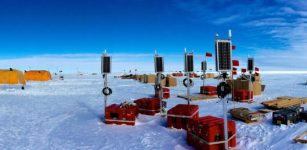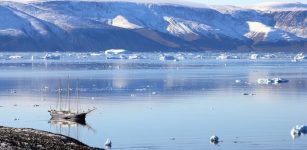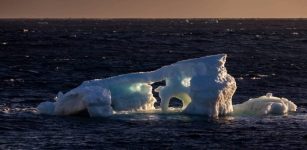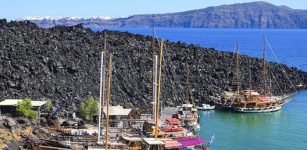Greenland Megatsunami Caused Week-Long Fjord Wave
Eddie Gonzales Jr. – MessageToEagle.com – In September 2023, a megatsunami in remote eastern Greenland sent seismic waves around the world, piquing the interest of the global research community.
The event created a week-long oscillating wave in Dickson Fjord, according to a new report in The Seismic Record.
Aerial overview of the study region, with the landslide location (yellow star) on the southern shore of the Dickson fjord. The green box is a simplified model of the seiching effect. Phase 1 corresponds to the landslide, Phase 2 marks the entrance of the landslide into the fjord, and Phase 3 is the megatsunami with water waves initiating a seiching process. | TSR (2024) Carrillo-Ponce et al.
Researchers identified two distinct signals in the seismic data from the event: one high-energy signal caused by the massive rockslide that generated the tsunami and one very long-period (VLP) signal that lasted over a week. Their analysis of the VLP signal — which was detected as far as 5000 kilometers away — suggests that the landslide and resulting tsunami created a seiche, or a standing wave that oscillates in a body of water. In this case, the seiche was churning for days between the shores of Dickson Fjord.
“The fact that the signal of a rockslide-triggered sloshing wave in a remote area of Greenland can be observed worldwide and for over a week is exciting, and as seismologists this signal was what mostly caught our attention,” said Angela Carrillo-Ponce of GFZ German Research Centre for Geoscience, in a press release.
“The analysis of the seismic signal can give us some answers regarding the processes involved and may even lead to improved monitoring of similar events in the future. If we had not studied this event seismically, then we would not have known about the seiche produced in the fjord system,” she added.
The research will aid in studying landslide impacts in Greenland and similar regions where global warming and permafrost loss are destabilizing rocky slopes and glaciers.
Recent tsunamis in western Greenland have been devastating. In 2017, an avalanche-triggered tsunami in Karrat Fjord flooded Nuugaatsiaq village, killing four. Megatsunamis over 100 meters high off Greenland’s east coast have even reached Europe. A megatsunami occurred in Dickson Fjord, East Greenland, on 16 September 2023. It was first reported on social media and through a military installation on Ella Island that experienced waves.
Carrillo-Ponce and colleagues studied both seismic signals and satellite imagery from the area to precisely locate and reconstruct the series of events.
Analyzing a high-energy seismic signal and satellite images of a cliff in Dickson Fjord, researchers traced a landslide’s path. It incorporated glacier ice, becoming a rock-ice avalanche before hitting water. The resulting megatsunami reached over 200 meters near impact and averaged 60 meters along 10 kilometers of the fjord.
“While we were able to obtain information on the direction and magnitude of the force exerted by the landslide, we do not have data to investigate the original cause of the landslide,” Carrillo-Ponce said.
The strength, radiation pattern and duration of the later seismic VLP signal best fit a scenario where the tsunami created a long-lasting seiche in the fjord, the researchers found.
VLP signals have been observed previously in Greenland, but they are usually associated with iceberg collapse due to glacial earthquakes. “In our case we observed a VLP signal too, but the main difference is the long duration,” Carrillo-Ponce explained. “It is quite impressive to see that we could use good-quality data from stations located as far as Germany, Alaska and North America, and that those records were strong enough for at least one week.”
The researchers say their approach might prove useful in studying similar past events, and their possible link to climate and environmental change. They compared the results with remote sensing data to validate our solutions.
The study shows that the force produced by the signals is well resolved,” Carrillo-Ponce said. “Therefore it becomes a useful analysis as seismic signals contain information on the type of source generating the signal and how the energy is radiated.”
Written by Eddie Gonzales Jr. – MessageToEagle.com Staff Writer











